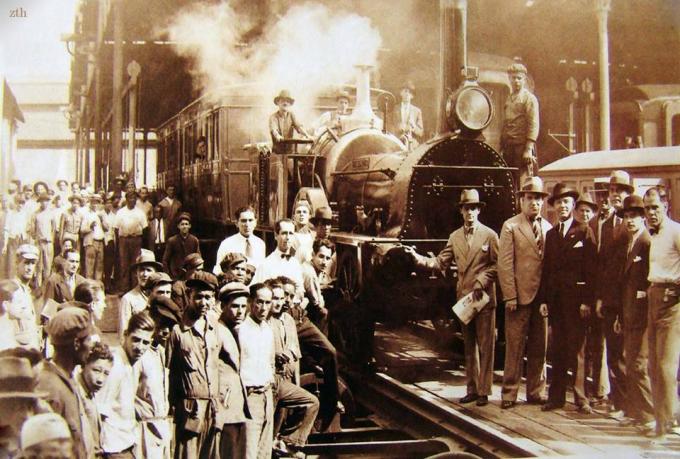is known for Industrial Revolution the great period of socio-economic development, which emerged in England in the 18th century.
At that time, manufactured work was replaced by steam machines, reinventing production dynamics and relationships between workers.
see more
Scientists use technology to unlock secrets in ancient Egyptian art…
Archaeologists discover stunning Bronze Age tombs in…
O capitalism gained strength and became the prevailing economic model in the world.
Textile production was the main activity developed at the beginning of the industrial age, followed by the construction of locomotives and railways.
Industrial Revolution in Brazil: summary and historical context
A Industrial Revolution in Brazil happened in a delayed and undeveloped way.
During this period of great changes in the world scenario, Brazil was still colony of portugal and suffered from the effects of the exploration of the metropolis in Brazilian lands under the Colonial Pact regime.
Thus, the opening of industries in the country was prohibited, leaving it to the colonists to sell manufactured products from Portugal.
As a result, the transformations of the Industrial Revolution only reached Brazil in the late 19th and early 20th centuries.
The main drivers of this movement were coffee growers in the State of São Paulo who, given the increase in production and export of coffee, decided to invest in machinery and, consequently, in the growth of the sector industrial.
In this period of time of the Brazilian industrial era, the most prominent activities were the processing of food and fabric production, exercised by medium and small industries commanded by the bourgeois class in rise.
Names like Barão de Mauá reinforced the Brazilian industrial incentive, through the construction of the first railroad, shipyard and iron foundry in the country.

Industrial development from the 1930s to 1940s
With the end of Republic of Oligarchies, made up of very wealthy landowners from the southeastern region of the country, Brazil was beginning its Industrial Revolution.
This advance took place during the period of the government of Getulio Vargas, from the 1930s onwards, with development incentives in the industrial areas of the country.
The process of industrialization in Brazil gained strength during the period due to the collapse of coffee production and trade, which experienced a considerable decline in income in the so-called Coffee Crisis.
Economic activities gained prominence in the urban centers of the cities of São Paulo and Rio de Janeiro. Janeiro, under the pretext of encouraging the production of consumer goods in the country and reducing the costly imports.
The Brazilian industrial sector received strong stimuli from the federal administrative government, especially during the mandates of Getúlio Vargas and Juscelino Kubitschek.
It is worth mentioning that during the period of Second World War, Brazilian industrial development underwent a slowdown, given the drop and interruption in the number of imports of machinery.
Vargas government and Kubitschek: the era of industrial incentives
A was Vargas was marked by nationalization of the economy characterized by the exchange of imports due to the incentive for the creation of the so-called “basic industries”.
The centralization of the country was governed under the precepts of the so-called new state, with the justification of containing the rising communist movement, in addition to guaranteeing greater political autarchy over the Legislative and Judiciary powers.
It was during his government that Getúlio Vargas created the Companhia Siderúrgica Nacional, primarily responsible for steel production, Petrobras in the energy production sector, in addition to Companhia Vale do Rio Doce, responsible for extracting resources minerals.
In addition, another notable feat of the president was the Consolidation of Labor Laws (CLT) with the intention of structuring and organizing the industrial labor sector.
Unlike the previous president, Juscelino Kubitschek opted for internationalization of the economy.
His idea was to open the nation to possible capital and foreign investors, especially those linked to the automobile industry.
The period was marked by the so-called tripod of the economy, with incentives from national private capital in the production of non-durable consumer goods, investments in energy and transport, investment of capital in the areas of communication and the application of private capital to the expansion of consumer goods industries durable.
The slogan “50 years in 5” defined the main intentions of the Kubitschek government, marked by economic growth while increasing external debts.


Main consequences of the Industrial Revolution in Brazil
A Brazilian Industrial Revolution resulted in the economic growth and development of the country.
Positively, the change in the structure of government brought the following benefits:
- Contraction in the volume of exports of foreign manufactured goods;
- Growth in the production of domestic products associated with a drop in prices;
- Generation of thousands of jobs in the industry sector;
- Development of labor relations in the areas of industries, with the creation of unions with the intention of defending workers' rights;
- Rise of the communication, transport and urban development sectors.
in relation to negative points, we can quote:
- Increased pollution with the release of chemical waste into the air and rivers, in addition to the practice of environmental crimes;
- Use of child labor;
- Unregulated growth of urban centers through rural exodus and immigration, unable to accommodate the large flow of people.
Related content:
- Coffee Cycle in Brazil
- 30's
